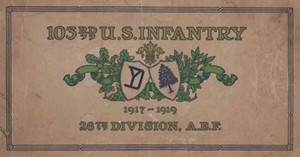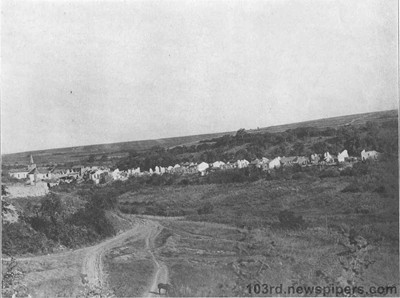
of the 26th Division of the U.S. Army
during World War I
 | The History of the 103rd Regiment of the 26th Division of the U.S. Army during World War I |
| Table of Contents | ||
CHAPTER VII
ST. Mlllllil.
F()lil.()\\`lN(i the relief of the regiment, July 2-L, the lst Battalion moved to
Bois cle Souillard, the 2nd to Souillard farm, and the 3rd to Roberts farm,
all of which were north and east of Montreuil. By August 1 the regiment, by
marching, had returned to the La Fcrtc area with Regimental lTealquarters,
and the lst Battalion at lissy with the 2nd and 3rd Battalions at Sammeron. Hvre
the men had a ehancc to clean up and rest, clothing and equipment shortages were
filled, and four hundred and seventy-five replacements received, but this did not
by any means bring the regiment up to strength.
Sunday, August 4, a memorial service for the regi1nent`s dead was held in the
park at Ussy with General Cole, Colonel Hume, and Chaplain Anderson as
speakers. The entire regiment was present and realized to the fullest extent the
significance of the days just Bnished.
Drill was taken up and the men soon were fit again. The river Marne was a
good friend to the men, and of an afternoon many took advantage pf thc chance
to bathe and swim. VVhile in this area odieers and men enjoyed twenty-four and
forty-eight-hour passes, the first since landing in France. Home went to Meaux,
others to Paris.
August 14 and 15 saw the regiment relieved from the La Forte area and on its
way to a real rest area, — the Chatillon-sur-Seine training area. The regiment
was moved by train to Chatillon, detraining at Poinqon, a short distance from
Chatillon, and was billeted in several small villages near there. Regimental
Headquarters were at Laignes; the lst Battalion at Bissey; the 2nd at Larry and
Marcenay, the 3rd and the Machine-Gun Company at Bouix and Cérilly.
The Chatillon·sur-Seine area was, so far as healthful conditions for the men -
good billets and good weather—thc best the men were ever in, at least until
moving towards home. VVe found a more prosperous native element, better homes,
and more of a chance to get a few extras in the way of food, in fact, plans were
made for at least a six-weeks rest; rosters for the men to go on leave were made
up and posted, only to be canceled by moving orders.
Orders arrived August 27 for the next move back to the front. The regiment
untrained at Poincon fer liar-le»Duc. detraining at Longevillc, a small village
southeast of there. The entire regiment had arrived by the thirtieth; in fact, the
whole division was on the move and, thanks to the ellicieney of the French troop-
transport system, cliaiigecl l`rom one area to another in remarkably short time
and good order. The trip tool; two nights and a day. linvnerliately on detraining
organizations were moved into the nearest woods to wait for darkness. This
corroborated the rumor heard even before leaving the Chatillon area that a drive
was to be made soon on the St. Mihicl salient; se·i·e·y and concealment were
important.
Then followed one of the liardsxt and yet most interesting of experiences, —long
night marches from dark to dawn. The route followed led north to Rupt-cn-
W'0evre, into which area the regiment had arrived by September 5. It had been
 by hard inxnivlnes, lmwr-x·¤·1·. (fredii is
due the Supply (Zoiupany for the eHi-
cient manner in whivli, though a long
way from a base, supplies rear·hed us;
of course this means that some good
start work was being done at Division
Headquarters, for this regiment was
only one unit, and the entire division
was on the move.
The men eoop·1·:t\erl in the matter
of secrecy excellently. Therewas some-
thing big pending, and they realized
it would he greatly to their benefit
to take every required precaution, On
September 6 the lst Battalion took
over a part of the front line——the
2nd and 3rd Battalions remained in
support and reserve.
It was known that an attack was
to be made, but the day was of course
not disclosed until the very last mo-
ment. Fortunately the weather had
been rainy and overcast and the
movement of troops well concealed.
The movement of supplies and artil-
lery had, however, been greatly handi-
capped. I recall well the night we
moved up to take our positions for
going over. Rain fell in torrents;
there were ammunition caissons, ma
chine-gun carts, troops; in fart, it
seemed as if nn army was on the
move, and it was. ()r¤lers were not
received until between eight and nine
0’eloek. The artillery preparation, of
which more will be saicl later, was to
start at one o’cloek, and it was abso-
The report of Captain Bisbee is here incorpomtcrl us am :mrurnt0 zwcoiint
of the great drive which lasted less than two days, but- m-tml an clean-mit
victory.
1I1·:.m;u.xm‘i·:xs, 1031m I`. S. INFANTRY,
19 Scpt., 1918.
From: Rcgimcntul Iiilciligciicc and Op(·mti0us ()liicc1·, 103rd Infantry.
Ta: Chief of Staff, 26I.h Division.
Subject: Report of Action 12th Scpt.—14th Sept., 1918, in St. Mihicl Salient,.
by hard inxnivlnes, lmwr-x·¤·1·. (fredii is
due the Supply (Zoiupany for the eHi-
cient manner in whivli, though a long
way from a base, supplies rear·hed us;
of course this means that some good
start work was being done at Division
Headquarters, for this regiment was
only one unit, and the entire division
was on the move.
The men eoop·1·:t\erl in the matter
of secrecy excellently. Therewas some-
thing big pending, and they realized
it would he greatly to their benefit
to take every required precaution, On
September 6 the lst Battalion took
over a part of the front line——the
2nd and 3rd Battalions remained in
support and reserve.
It was known that an attack was
to be made, but the day was of course
not disclosed until the very last mo-
ment. Fortunately the weather had
been rainy and overcast and the
movement of troops well concealed.
The movement of supplies and artil-
lery had, however, been greatly handi-
capped. I recall well the night we
moved up to take our positions for
going over. Rain fell in torrents;
there were ammunition caissons, ma
chine-gun carts, troops; in fart, it
seemed as if nn army was on the
move, and it was. ()r¤lers were not
received until between eight and nine
0’eloek. The artillery preparation, of
which more will be saicl later, was to
start at one o’cloek, and it was abso-
The report of Captain Bisbee is here incorpomtcrl us am :mrurnt0 zwcoiint
of the great drive which lasted less than two days, but- m-tml an clean-mit
victory.
1I1·:.m;u.xm‘i·:xs, 1031m I`. S. INFANTRY,
19 Scpt., 1918.
From: Rcgimcntul Iiilciligciicc and Op(·mti0us ()liicc1·, 103rd Infantry.
Ta: Chief of Staff, 26I.h Division.
Subject: Report of Action 12th Scpt.—14th Sept., 1918, in St. Mihicl Salient,.
|
||
| Original Version of Page |